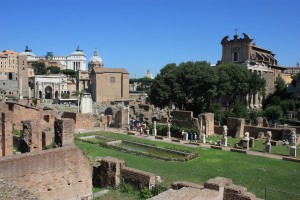Two millennia ago, Rome was rocked by three plots that threatened to overturn the republic. While each of these plots was named for just one man, Lucius Sergius Catilina, scholars now discredit his involvement in the first of these plots. Nonetheless, the three Catilinarian conspiracies are perhaps the best documented civic events in the history of the Roman republic. The reason is that two excellent contemporary sources have survived. The first is a series of four speeches by the eminent lawyer, Marcus Tullius Cicero. These speeches are collected In Catalinam (Against Catiline). (Last summer, I echoed the very famous beginning of Cicero's first speech against Cataline in this post ("Pray, how long . . .").) The other source is the history written by Gaius Sallustius Crispus (known as Sallust in English), De Coniuratione Catilinae or Bellum Catilinae. Cesare Maccari's famous 1888 painting, Cicerone denuncia Catalina, depicts the dramatic confrontation of Cicero and Catiline.
Did the Romans Invent the Advance Notice Bylaw?
Recently, I was re-reading some of Cicero's political speeches and it occurred to me that perhaps the Romans should be credited with the invention of the advance notice requirement for nominees. The catalyst for Catiline's extra-legal efforts to seize control of the republic dates to 65 B.C.E. when he tried to run for election to the consulship but was blocked from entering the race. Here's Sallust's explanation:
Post paulo Catilina pecuniarum repetundarum reus prohibitus erat consulatum petere, quod intra legitumos dies profiteri nequiverat (Shortly therafter, Catiline, having been prosecuted again for embezzlement, was forbidden to seek the consulship, because he was unable to declare his candidacy within the lawful days).
Lucius Sallustius Crispus, De Coniuratione Catilinae, ch. 18, l. 3-5 (my translation). In other words, Catiline was ineligible because he had failed to give the requisite advance notice, which was approximately 17 days.
So Where Do Togas Come In?
The great epic poet, Publius Vergilius Maro (Vergil), famously called the Romans "the toga clad people". Aeneid, Bk. 1, l. 282. When a Roman candidate ran for office, he wore a whitened toga known as candida toga. Hence, persons running for office to this very day are known as "candidates".
The Roman Forum - Where Cicero and Catiline walked. The square building in the center is the Roman senate building that was built in 44 B.C.E. and survives to the present day.



.png?width=100&height=100&name=corporate_law_blogs%20(1).png)